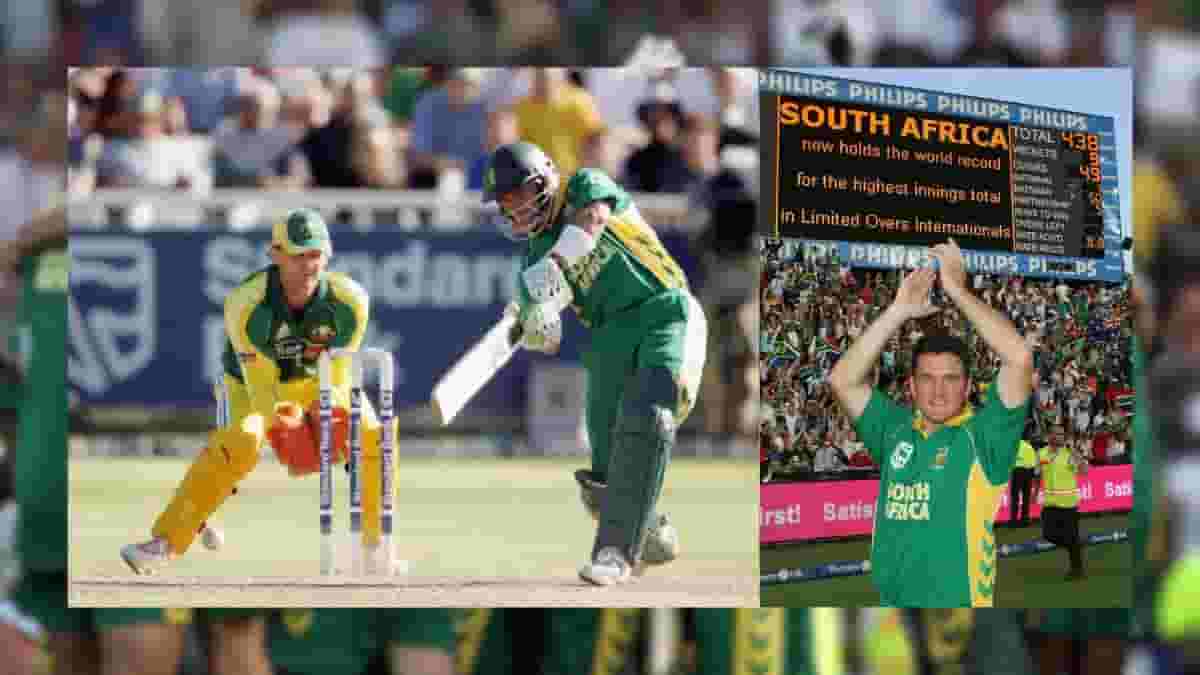 Source: X
Source: X
In recent times, cricket has become a sport which is very much dominated by hard-hitting batters. T20 cricket has allowed teams to get a closer look at players with abilities to make a difference while batting for just 20-25 balls. The new rules of two new balls in ODIs as well as one less fielder outside the 30-yard circle have made sure that monumental totals are scored with relative ease nowadays. But this wasn’t the case in 2006 when the highest runs were scored in an ODI match. It has been more than 17 years since then and still, the record for highest runs scored in an ODI match is still held by the match at Johannesburg between Australia and South Africa.
Highest runs scored in an ODI match
During the fifth and final ODI of Australia’s tour of South Africa in 2006, the record for scoring most runs in an ODI match was made. Before this match, no team had ever breached the 400-run mark in ODI cricket. On 12th March 2006, the 400-run mark was breached twice as history was created at New Wanderers Stadium, Johannesburg. South Africa and Australia combined scored 872 runs in 99.5 overs at a run-rate of 8.73.
South Africa vs Australia, 2006
1st innings- Australia’s batting
Australia won the toss in the fifth ODI and skipper, Ricky Ponting had no hesitation while choosing to bat first. Opening the innings for Australia, wicketkeeper, Adam Gilchrist and Simon Katich made half-centuries. Gilchrist made 55 runs in 44 balls while Katich made 79 in 90. After the first wicket fell at 97 runs, Ponting came in to bat. Ponting played a crucial role in Australia becoming the first team to score 400 runs in an ODI inning. The Australian skipper scored a daddy hundred and made 164 runs in 105 balls hitting 13 fours and 9 sixes. Ponting first shared a 119-run stand for the second wicket with Katich. Once Katich was dismissed by Makhaya Ntini all hell broke loose as Michael Hussey came in to bat.
Hussey played a quickfire cameo and scored 81 runs in 51 balls. Ponting and Hussey shared a 158-run stand for the third wicket. Hussey was then dismissed by Andrew Hall while playing a loft shot over long-on where Ntini took the catch. During the dying stages of the innings, Ponting was finally dismissed by Roger Telemachus as the Australian skipper played a drive to deep cover where Boeta Dippenaar took the catch to end the greatest knock in ODIs till that time. Andrew Symonds made 27 runs in 13 balls lower down the order to get Australia to a total of 434 runs. For South Africa, Telemachus was the most expensive bowler conceding 87 runs in his 10 overs. Coincidentally, Telemachus picked the most wickets for South Africa as well including the important wicket of Ricky Ponting. Both Hall and Ntini picked up one wicket each while conceding 80 runs in 10 and 9 overs respectively. Jacques Kallis conceded 70 runs in his six overs. The bowlers also gave away 19 extras in the first innings.
2nd innings- South Africa’s batting
South Africa’s chase of the historic total did not start on a positive note as they lost opener, Dippenaar on the 8th ball of the innings with just three runs on the board. Just like in the first innings, it was the number three batter who would go on to create history. Herschelle Gibbs scored a daddy hundred and made 175 runs in just 111 balls hitting 21 fours and 7 sixes. Skipper, Graeme Smith while opening the batting scored 90 runs in just 55 balls. Smith and Gibbs shared a 187-run stand for the second wicket. AB de Villiers at number four couldn’t get going and just played a great second fiddle to Gibbs. de Villiers scored just 14 runs in 20 balls. Gibbs was dismissed by Symonds inside the 32nd over. When Gibbs was dismissed the hosts still needed 139 runs in 109 balls.
Wicketkeeper, Mark Boucher remained not out and scored 50 runs in 43 balls. Kallis scored 20 runs in 21 balls. Lower down the order allrounder, Johan van der Wath scored 35 runs in just 18 balls hitting 1 four and 3 sixes. In the last over Brett Lee needed to defend 6 runs while Boucher and Hall were at the crease. Boucher took a single off the first ball and Hall smashed over mid-wicket for a four. South Africa needed just two runs in four balls to create history. Hall threw his wicket on the third delivery as played a drive straight to mid-on. South Africa needed two runs in three balls while the visitors only needed one wicket. Number 11 batter, Ntini pushed a good length delivery to tie the scores with two balls remaining and put Boucher on strike. Boucher played a drive over mid-on to seal the victory for his side with a boundary.
The series was tied at 2-2 and after the first innings many fans and experts thought that Australia would seal the series but Gibbs and the South African batting line-up had different plans. With 872 runs scored across the two innings, the match between South Africa and Australia has been immortalised in the history of cricket.




